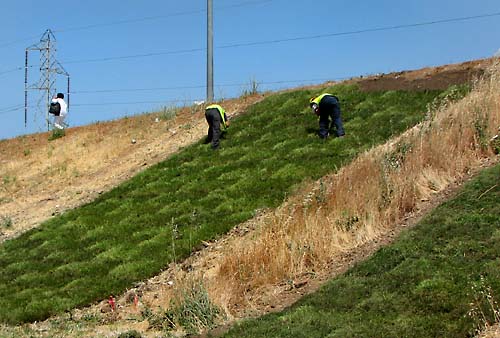Erosion Control Toolbox: Native Grass Sod
Introduction

Native grass sod treatment involves placement of commercially grown sod that is composed of a mixture of drought-tolerant native California grass species.
When to Use This Treatment
- Wherever immediate 100 percent cover of disturbed soil areas is required
- Biofiltration Strips and Biofiltration Swales
Benefits
- Provides immediate soil cover and control of surface erosion
- Research data showed that a freshly tilled 2.5:1 (H:V) slope treated with hydroseed yielded 1-2 tons/hectare/year of sediment loss while the native grass sod yielded only 0.6 tons/hectare/year of sediment loss
- Greatly reduces competition from invasive weed species
- Low long-term maintenance and establishment costs
- Controlling erosion at the source is more effective than removing sediment or metals from stormwater runoff downstream
- Sod strips placed at the toe of the slope remove soil particles from surface runoff before it leaves the project site
Limitations
- High initial cost
- May require supplemental irrigation
Technical Design Tips
- Amend soil with compost and/or slow-release organic fertilizer
- Germinate and kill weeds prior to amending soil, if possible
- Install just prior to the rainy season, if possible
- Supplemental irrigation may induce dominance of native grasses over others, and increase competition from invasive weeds
- Recommended grass species mixes vary by ecoregion. The best mixes develop a strong, contiguous root mat, easing harvest and precluding propagation of weedy seed species in the underlying soil
- Availability must be verified prior to specifying
Consider Using With
Standard Specifications
Estimate Information
Reference
- California Department of Transportation, "Using Reinforced Native Grass Sod for Biostrips, Bioswales, and Sediment Control" (PDF), December 2008
Updated: January 14, 2019

